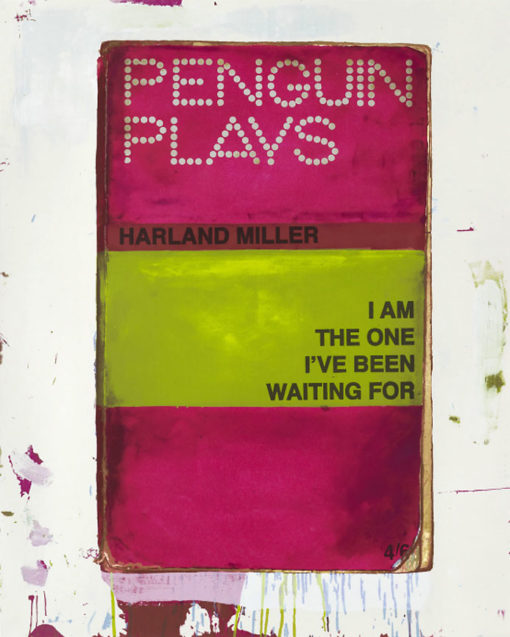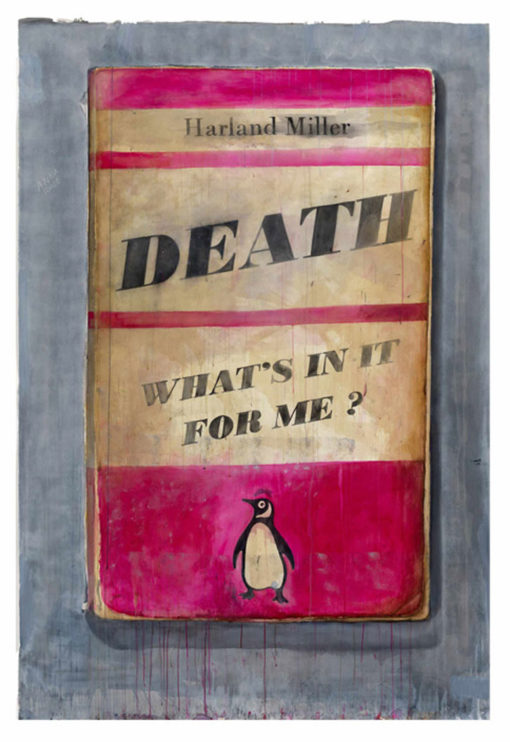Like many Pre-Millennial truths that were once irrefutable, the adage, “Don’t judge a book by its cover” is waning into obsolescence. After all, what is the utility of a book cover in the era of e-books that claim neither form nor substance? In his exhibition “Overcoming Optimism”, the artist Harland Miller obfuscates the issue further with prints of his paintings of vintage Penguin paperback front covers modified by what the artist assumes to be hilarious puns and helpful maxims for the iGeneration. The images that Miller has decided to paint are hardly demanding; in fact, they’re so visually and conceptually facile that the Ikon Ltd. press release resorts to claiming that “Pop Art, abstraction and figurative painting” were all involved in the creation of these “cover versions”. Classic Penguin paperbacks often sported covers by noted figurative artists such as Norman Thelwell and Margaret Belsky, but don’t look for any coy appropriations of their illustrated covers here as Miller doesn’t seem up to the challenge.

Harland Miller, I Am the One I’ve Been Waiting For, 2012, 49 1/8 x 39 3/8 inches, Silkscreen print, Edition of 50. Photo courtesy Ikon Ltd.
Born in 1964, Miller is firmly a member of Generation X, but several pieces in this show replace his age group’s characteristic skepticism with Faux-Millennial egocentrism. In the piece, “I Am the One I’ve Been Waiting For,” Miller deftly uses the first-person singular to ungraciously introduce us to his psychic onanism. Meanwhile, the print, “Death, What’s in it for me?” evidences how the Grim Reaper’s ultimate threat has been neutralized by the Millennial belief that, while previous generations had to cheat Death to avoid it, all they have to do now is ignore it. It’s reassuring to know that, so long as men can breathe or take selfies, Death shall not brag thou wander’st in his shade. Still, it’s not clear if the appeal of this print is Miller’s arrogant questioning of Death’s function and how it affects his ego, or bravery the spectator hopes to osmose from such braggadocio.

Harland Miller, Death, What’s in it for me?, 2011, 37 13/16 x 26 inches, 10 color silkscreen print, Edition of 50. Photo courtesy Ikon Ltd.
Other prints in the show deliver book titles that neither inspire nor intrigue after their moment of kitsch appeal fades. “This is Where Its Fuckin’ At,” may give the GPS coordinates to a hipster Nirvana, but such a claim is meaningless in a consumer society where just about every product makes the same assertion. “Blonde But Not Forgotten” is essentially a one liner that steals its laughs from other jokes, as is the stoneresque “There’s No Business like No Business.” Still, with titles like these, its a shame that the gallery doesn’t have Miller’s “critically acclaimed” books available as it would be interesting to see how long he is able to maintain this wordplay.

Harland Miller, This is Where Its Fuckin’ At, 2012, 56 1/2 x 43 1/4 inches, 15 color screenprint, Edition of 50. Photo courtesy Ikon Ltd.
Maybe it doesn’t matter that these compositions are graphically derivative and inspirationally flat. Or that it’s a middle-aged man playing a Millennial game in an attempt to come across as a smarmy sage. What matters is that if one can’t judge a book by its cover, all that’s left to judge is a cover without its book.
Harland Miller, September 8 – November 3, 2018
Ikon Ltd., Bergamot, Gallery D3, 2525 Michigan Ave., Santa Monica, CA 90404
(310) 828-6629, http://ikonltd.com and http://instagram.com/ikonltd/


